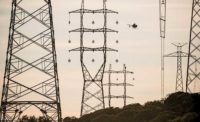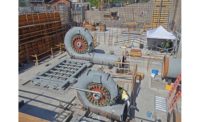ENR New England's 2017 Best Projects
Best Energy/Industrial: Sea2shore: The Renewable Link

The first project to interconnect the nation’s first commercial offshore wind farm to the mainland power grid made Rhode Island the first state in the nation to benefit from this type of renewable power source.
PHOTO COURTESY NATIONAL GRID

The first project to interconnect the nation’s first commercial offshore wind farm to the mainland power grid made Rhode Island the first state in the nation to benefit from this type of renewable power source.
PHOTO COURTESY NATIONAL GRID

The first project to interconnect the nation’s first commercial offshore wind farm to the mainland power grid made Rhode Island the first state in the nation to benefit from this type of renewable power source.
PHOTO COURTESY NATIONAL GRID

The first project to interconnect the nation’s first commercial offshore wind farm to the mainland power grid made Rhode Island the first state in the nation to benefit from this type of renewable power source.
PHOTO COURTESY NATIONAL GRID




Sea2shore: The Renewable Link
Rhode Island
Best Project
Owner/Civil Engineer/MEP Engineer: National Grid
Lead Designer/General Contractor: LS Cable America Inc.
Consulting Engineers: POWER Engineers Inc.; Black & Veatch
The first project to interconnect the nation’s first commercial offshore wind farm to the mainland power grid made Rhode Island the first state in the nation to benefit from this type of renewable power source.
The approximately $125-million project, which took 10 months, significantly reduced Block Island’s reliance on diesel generators to produce its electricity, ushering in an “era for the development of one of the key renewable resources that will help the U.S. secure its clean energy future,” according to National Grid.
The new undersea cables, which include fiber optic strands needed for the wind farm operations, also give Block Island the option to build out its first island-wide broadband network.
One Best Projects judge called the undertaking a “significant and historic engineering feat” because of the coordination of submarine, land and island locations. Another judge was impressed with the “immense teamwork” required for the highly technical project.
Developing the infrastructure to interconnect Deepwater Wind’s Block Island Wind Farm included installation of 25 miles of 34.5-kV undersea and underground cable built to National Grid’s specifications. The infrastructure also conformed to industry standards and was custom-designed to meet the requirements of the interconnections for the 30-MW, five-turbine offshore wind farm.
The scope of work also included construction of a National Grid 34.5-kV substation on Block Island Power Co. property. For this, crews installed approximately 0.8 mile of underground cable from Block Island’s Crescent Beach to the new BIPCo property, where the line transitions to an overhead line for approximately 0.2 mile until it reaches the new substation. Crews also installed 20 miles of 34.5-kV submarine cable in water as deep as 130 ft from Crescent Beach to the mainland’s Scarborough State Beach.
The team collaborated with multiple local, state and federal agencies to minimize impacts to the environment and existing utility infrastructure along the cable route. Those collaborations also helped coordinate the crossing of federal and state waters while making two landfalls with the submarine cable.
Significant daily coordination took place during the submarine installation. The contractor issued a daily notice to mariners as required by the U.S. Coast Guard. The project’s fishery liaison also issued daily briefings to commercial fishermen, and National Grid’s hydro-acoustic monitoring team communicated with the captain of the dynamic positioning cable-lay vessel.
The project was completed on schedule and under budget. Because Block Island’s economy depends on tourism, the team not only had to finish the job before the summer season, it had to ensure the beaches where cable made landfall were returned to their preconstruction condition.
Related Article: Innovation Permeates Region's Top Work







